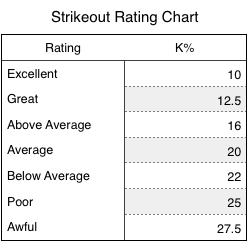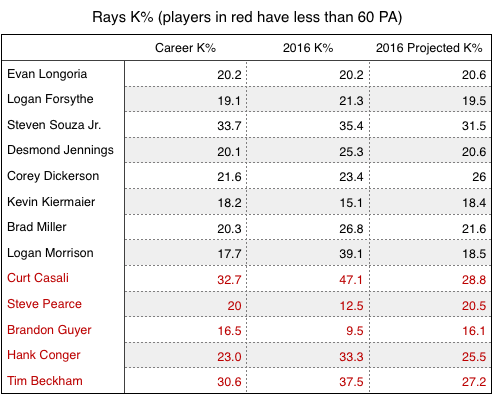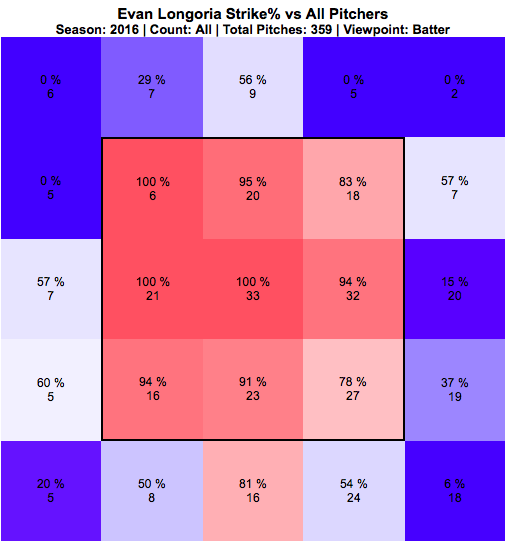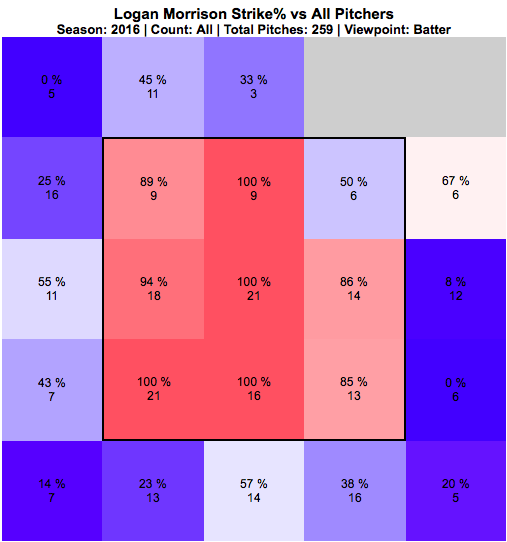
Here we are, about a month into the season, and most of the everyday players in the Tampa Bay Rays lineup have racked up anywhere between 51 and 99 plate appearances. While it is easy to look at a particular player’s batting average and conclude that he is performing at a certain level, be that good or bad, only one statistic offers a valid measurement at this point in the season — strikeout percentage (K%).
Allow me to expand on the subject.
Strikeout percentage is a statistic based on total plate appearances. It can be used to make inferences about a player based on a certain sample size — in this case 60 plate appearances, when strikeout percentage tends to stabilize. To put things in perspective, beyond the watermark of 60 plate appearances, it is unlikely that a player’s strikeout percentage is based solely on random variation.
It is, typically, the first statistic to be analyzed because of the incredibly small sample size needed to accrue information. Walk percentage follows, stabilizing at 120 plate appearances, while home run rate stabilizes at 170 plate appearances — so on and so forth. You can read an excellent article on statistics and sample size at Baseball Prospectus.

Note: The chart above is meant to be used as an estimate. League-average strikeout rates vary on a year-by-year basis.
The question begs, how are the everyday players on the Rays’ roster looking so far? Let’s take a look.

The above average to average — Kevin Kiermaier, Evan Longoria and Logan Forsythe
At this time last season, the slap hitting Kevin Kiermaier had posted a 17% strikeout percentage, which certainly isn’t terrible by any stretch of the imagination. This year, however, he’s lowered that rate by almost two or three points, depending on whether you’re looking at his career K% and/or the 2016 projection. He’s also improved in three other key areas: OBP (.329, up from .298), wOBA (.340, up from .309) and BB% (9.2, up from 4.5). In short, Kiermaier is striking out less and reaching base more often. At a time when the team mantra espouses the virtues of being aggressive at the plate, he is laying off pitches outside of the zone. There likely will be plus/minus fluctuations over the span of the next 138 games, but barring any major change in his approach, Kiermaier looks to be a player who is putting together better at-bats and striking out less…at least in the present tense.
Both Evan Longoria and Logan Forsythe’s strikeout percentages are up from last season — Longoria 20.2% (up from 19.7%) and Forsythe 21.3% (up from 18.0%). I’d argue though, that a slightly inflated K% is a byproduct of the team’s more aggressive approach at the plate. 20 or 21 strikeouts for every 100 plate appearances are negligible changes at best.
Logan has dramatically improved his OBP by 59 points — up from .359 in 2015 to .418 thus far. To that end, at least he’s reaching base at a greater clip, and I’d expect his K% level out to his career norm by the end of the season.
Longoria told Roger Mooney (Tampa Tribune) that he is pleased with his power numbers to date, although he still seeks to boost his overall production. Unfortunately Longoria is swinging through a good number of pitches on the upper, lower and inside fringes of the zone, as well as pitches over the inner third of the plate. If he can lay off pitches down and over the heart of the plate, while making contact with those within the zone, he can start to put together those crucial more productive at-bats.

The worrisome — Desmond Jennings, Brad Miller, Steven Souza Jr., Logan Morrison, Curt Casali
After missing most of last season, yet predictably doing well during Spring Training, Desmond Jennings finds himself offensively strapped and striking out just over 25% of the time. When he does make contact, it’s more often soft (28.8%) or medium (48.1%).
Brad Miller started the year by striking at an ugly clip (19 times in 58 plate appearances). However, since moving up to the two hole back on April 26, Miller has struck out just once. Sure, his 26.8% strikeout percentage is a worrisome figure. However, consider that he struck out 33% of the time up to April 25th, and just 6% of the time since.
Despite striking out 35.4% of the time, Steven Souza Jr. has been productive at the plate, collecting five homers and 11 RBI. He’s also lowered his strikeout percentage from this point last season. Still, he was projected for a 31.5% strikeout percentage this season by ZiPS. It certainly doesn’t help that he’s struck out seven times in his last 16 plate appearances, while collecting just two hits in that span.
The crowning acquisition of the past offseason, Logan Morrison was expected to offset his sub-Gold Glove caliber defense with some thump at the plate. However, after stepping to the plate 68 times in 2016, Morrison has struck out a gaudy 39.1% of the time. Ouch! There may be a ray of hope for the maligned first baseman, he’s struck out more that 18% of the time just once in his MLB career — 18.9% in 2011 with the Marlins. Can he make the adjustment and lower his strikeout percentage to something that resembles his career or projected numbers? Sure…although he’ll have to do something about the holes in his swing within the strike zone.

Curt Casali has struck out a staggering 47.1% of the time. Thankfully when he makes contact it’s either medium (36%) or hard (40%). I read a funny tweet where Casali was referred to as Curt “Shoppach,” and he really hasn’t done much to shed the moniker. The hope is that he can lower that percentage with more consistent play, even if his numbers don’t bear that out. A caveat: he’s only accrued 51 plate appearances though I don’t really foresee a tremendous change in nine more.
Conclusion
The team, as a whole, has posted a 26% strikeout percentage (five points higher than the MLB average). That number is largely due to their aggressive 48.2% swing percentage. A free swinging team is one that hits a lot of homers, yet also strikes out at an uncomfortable pace. Pick your poison.
To be clear, strikeout percentage (as with any other statistic) is fluid and can change for better or worse. It can decrease when a batter makes the proper adjustments at the plate. Take former Ray Wil Myers for example. Myers lowered his below average 24.9 K% in 2014 to an average/above average 19.4% at this point last season with the San Diego Padres.
Be that as it may, in order for Jennings, Miller, Souza, Morrison and Casali to blossom into the players Silverman envisioned, those adjustments will need to be made.
Noteworthiness
— On Thursday JJ and I will continue our team analysis with a breakdown the Rays first month of play.
